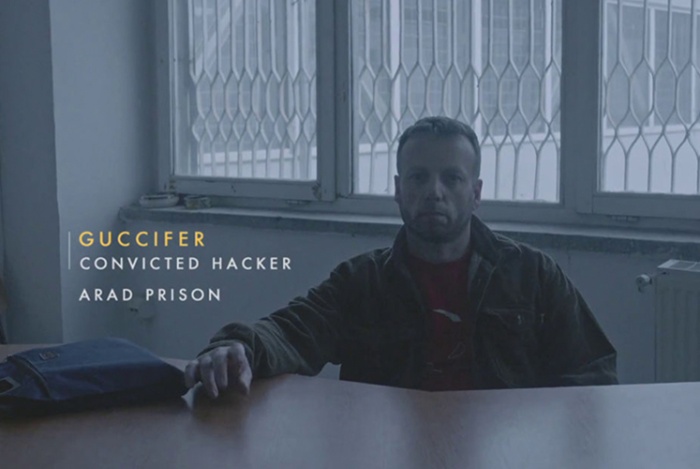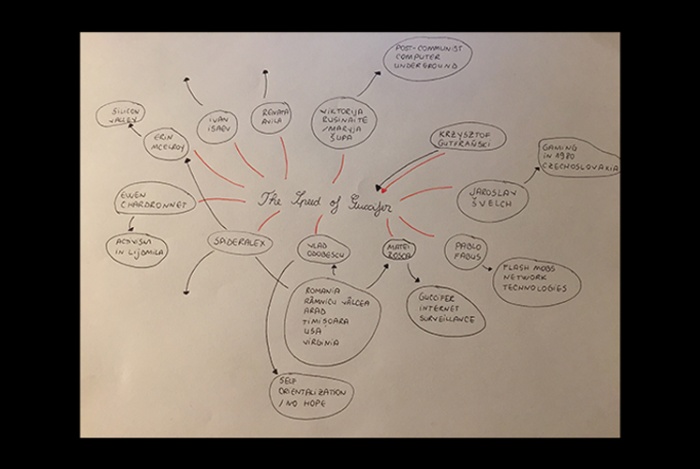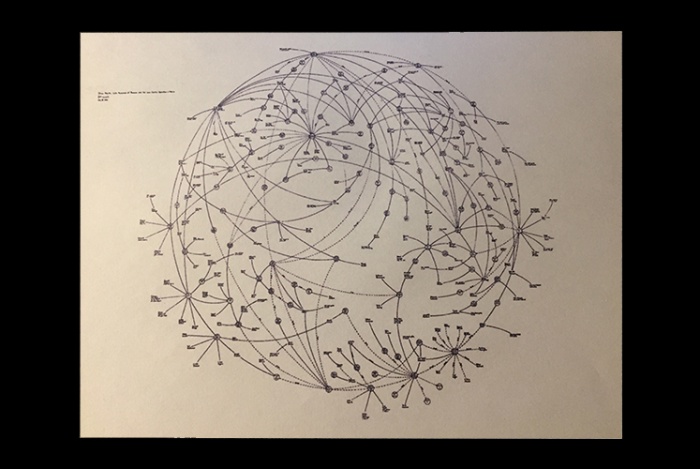[H]ackers are free people like artists. If artists get up in the morning feeling good, all they do all day is paint. […] The same goes for hackers. They wake up in the morning and read about something going on in international relations. If they are feeling patriotic, they will try to take their own stand in to what they believe to be the righteous fight against those who are against Russia.1
— Vladimir Putin
He who controls the Internet servers controls the intellectual record of mankind, and by controlling that, controls our perception of who we are, and by controlling that, controls what laws and regulations we make in society.2
— Julian Assange
The current issue of Obieg begins and ends in Romania, on the way traversing a region that does not fit into the concept of “Western Europe.” We look at selected examples of artistic creativity and the political engagement of hackers from Central Europe and the Balkans and explore the still overlooked potential of this region, in the process confounding the claim that, even today, to travel from Brussels to Bucharest is to travel in time. Here we have expanded our sphere of interest, which until now has revolved around the ecological and migration crisis as well as the ways of writing about culture and art, to encompass the issue of technological crisis. Although this is a problem of great importance and scale, it is paradoxically one of the most often underestimated. We pursue this theme all the more vigorously the more convinced we become that there must exist alternatives to the technologies created in Silicon Valley – since the ones offered by China, Russia, or Iran are hardly the answer. We are therefore launching a discussion which we want to develop in our magazine throughout 2020.
The inspiration and opening premise of The Speed of Guccifer is the development of cybercrime and its impact on the collective imagination in postcommunist Romania, as well as the perception of hacking as a means of redistributing the unequal opportunities for the future, in which this Central and Southern European asset has been overlooked. Romanian cybercrime has its origins in the reforms of the Ceauşescu regime, when – contrary to the recommendation of the Soviet Union, which tried to ram through the development of Romanian agriculture, the country decided to back information technology and computer programming, also expanding other new technologies of that era. During the free-market transformation in Romania and other countries in the region, hundreds of experts including high-caliber engineers educated in the preceding political system had little chance of finding a job and just as little control over their own future. The next generations, equally on the sidetrack of history, grasped the new opportunities that the World Wide Web and the new technologies brought with them. As a result, Central and Southern Europe have become an oasis of hacking and cybercrime. One example is the city of Râmnicu Vâlcea, situated at the foothills of the Carpathian Mountains in central-south Romania, which achieved global notoriety as “Hackerville” thanks to the spectacular feats of the local hackers who penetrated the computer security of such powerful institutions and companies as NASA, the White House, and Google.

Klatka z fimu "The Most Dangerous Town on the Internet", reż. Daniel Junge, Norton, 2015.
Guccifer, as Marcel Lazăr Lehel has come to be known, does not hail from Hackerville. He has raised hacking to the level of an art. Lehel was an unknown taxi driver, living not far from the city of Arad. This talented amateur can be described as one of the last hacktivists. Guccifer stood out from many other hackers in the region. In terms borrowed from traditional westerns, where the bad guy wears a black cowboy hat, and the good guy wears a white hat, we pigeonhole the type of hacker according to their motivations, and whether or not they are breaking the law, dividing them into “black hats” – those working in the sphere of political engagement sometime considered crime; “white hats” – ethical hackers who work in commercial cyber security, and “grey hats” – who engage in cybercrime such as credit card fraud known as “carding” and other activities aimed primarily at stealing money on the internet. Guccifer built his fame in the simplest possible way: by hacking the internet accounts of the celebrities and high-level US public figures and using the contacts that people make on the internet to gain insight into the private lives of the most powerful and famous people on Earth. He leaked his discoveries – both the important ones and celeb trivia – to the internet media fueled by leaks and snooping. Perhaps Guccifer – a noble simpleton rebel, who when the cookie crumbled was no more than a peddler of trivia – was what the West craved at the time, since it indulged in regarding the southern and eastern periphery countries as backwards in their level of civilization, a sphere of shady deals and corruption. At least to some degree, Guccifer’s actions were undertaken for noble reasons and carried out pro publico bono – bringing him, in a sense, closer to the WikiLeaks activists. However, they must also be viewed in the local context of Romania and bearing in mind Central Europe inferiority complex and a fervent desire for greater visibility.
Why “Guccifer?” Lucifer was a rebel angel, and Gucci – a symbol of stylish consumerism, with numerology thrown into the mix. As Lehel explained, “Split Guccifer into numbers and you’ll get 72, which is known as an absolute number of divinity. Google it.” The name was also a talisman: “They’d rather have me dead but I came out with this name to protect me. The services wanted to liquidate me.” Lehel thought himself guided by “external intelligence.” “In China, there are entire buildings full of professional hackers, who have not achieved what I have.” He hinted that the secret police were interested in his collaboration, but he refused. “I said our purposes don’t coincide. We fight on different fronts.”3 Guccifer hacked the account of the former President George W. Bush, revealing to the world his painting talents complete with some of his self-portraits, and went on to compromise a host of high-level politicians, including the US Secretary of State Colin Powell and Sidney Blumenthal, Hilary Clinton’s long-standing adviser. His comments intended for Clinton’s eyes on the attack of the USA consulate in Bengazi in 2012 provided a spurt of excitement for conservative bloggers. Guccifer boasted of exposing a global conspiracy, but his forte was gossip, of interest mainly to the tabloids. In the end, he abandoned all political pretensions and hacked Jeffrey Tambor, who starred in Arrested Development, and the Vanity Fair editor Tina Brown – clearly tabloid titbits were where his heart was.
Like journalism, hacking still has the potential to uncover the truth – although it is primarily driven by egotistic reasons of attention-seeking economics. Guccifer wanted to dominate the discourse and in that he succeeded. He had a natural gift for playing the media, cultivating his relationship with the press and seeding his stories like a seasoned PR pro. Guccifer’s favorite website was The Smoking Gun, which often ran his leaks. He handed George W. Bush’s self-portraits to the celebrity media blog Gawker, and followed up with many more revelations.
Guccifer’s modus operandi and his story are reminiscent of the American artist Mark Lombardi, the first artist to explore metadata. Of course, Guccifer went a step further, exploring not only widely available information but also stolen data. Lombardi’s art involves large-format diagrams of crazy spirographic patterns, created with curved and straight lines, precisely drawn on paper in pencil, which revealed the global networks of corrupt power brokers. Processing the available data before the arrival of the online boom, Lombardi created a visual history of the links between the intelligence community, organized crime, corporations, and offshore shell companies with shadow banking, together with the scandals and catastrophes that occurred at the juncture points. The constellations of these intricate diagrams reveal the interactions between the Vatican, Oliver North and the Bush family, as well as the mafia.

Diagram połączeń w Obiegu #12 zestawiony z pracą Marka Lombardiego.

The methods and goals of Guccifer and Lombardi were similar, although the Romanian hacker shows the artistic awareness of an outsider, and also to an extent more ambitious in its research, as well as spiced with a heavy dose of conspiracy theories. Guccifer had access to one of the fastest internet connections at that time, as well as no moral compunction whatsoever. He was not a typical hacker – he would guess email passwords and ploughed through tons of private correspondence of hundreds of people, joining the dots and identifying the next victims in his private crusade for the truth. Just as Mark Lombardi intended to achieve in his diagrams, aware as he was that the network of corruptions feeds on secrecy, a lack of transparency and therefore stays away from the spotlight in every manner possible, Guccifer, working with his tools of choice through processing the metadata and his cache of captured secrets, revealed what existed below the radar of public awareness.
With hindsight, the Guccifer saga can be interpreted as a story of a globalizing Eastern Europe, while at the same time as, in a nutshell, how the internet has evolved over the last five years. Guccifer placed himself right in the center of the world of conspiracy plots, culture wars, populism, identity politics, and superpower struggle for domination. In an ironic postmodern twist, he himself was finally hacked by a phantom Guccifer 2.0 persona created by Russian military intelligence as a cover-up for their interference in the 2016 U.S. presidential election.
Hacking – which until recently had been the preserve of individual anti-establishment rebels and cybercriminals and used by both groups to penetrate, unauthorized, computer systems – has been taken over by state and corporate entities and used to garner information for better social control and commercial profit.
To understand how the world works, one has to deal with what is here and now. This is true both about Guccifer and other figures such as Julian Assange, Chelsea Manning, Jeremy Hammond, Barrett Brown, or Edward Snowden. It is hard to say whether the internet was once a revolutionary force, but it certainly represents a technological revolution. It is a tool for many purposes, both good and evil. The World Wide Web was invented in 1989 by the British scientist Tim Berners-Lee, who originally conceived and developed it to meet a demand for information-sharing scientists in universities and institutes around the world. Unlike today’s CEOs of web platforms such as Google, Amazon, or Facebook, however, Berners-Lee didn't become a billionaire from his creation despite its impact on society – because he gave it to the world for free, with no patent and no royalties due, so the whole world could benefit from the free space of global communication and interlinking. The Web’s Golden Age, which lasted for some two decades, is now becoming a thing of the past. What was once an apolitical tool for furthering science for the benefit of all humanity, has been today weaponized by governments as a tool of mass invigilation and political meddling. With the arrival of the Brave New World of the Internet of Things – where we cannot be sure that our TV set or a fridge are not spying on us – the battle is heating up to protect individual online privacy and anonymity of users while maintaining the democratic access for all. Clearly, it is no good hoping for government-level political action, since some states, China for one, police and restrict their citizens’ free access to the net. The battle for access to knowledge has opened up a space for a movement that encompasses a large spectrum of players, from librarians to radical investigative journalists, from hacktivists engaged in a fight against the Trans-Pacific Partnership to artists exploring new forms of creativity without seeking a copyright.
The problem perhaps lies in the dubious nature of the philosophical premises behind the discourse on online security and its current role. What information remains secret today? Guccifer implies that the content of the act of “occult” is secret, mass hypnosis to which mainstream media have subjected everybody, reinforcing ad infinitum Thatcher’s manipulative mantra that “there is no alternative.” The truth is hidden somewhere inside the box; if you have the key, you can access it and make it public. For centuries, if not millennia — if we go back to the Trojan horse ruse, history’s pivotal points relied on manipulation, conspiracy, lies, deception, and simulation. These tactics have intensified in the hands of modern political subjects such as nation-states, armies, and political parties. Hacking and organic struggle for free access to the internet seems to be just about the sole way to reclaim a degree of popular sovereignty over the control of information in countries where this is still possible. At the moment, these seem the only available tools of self-defense available to internet users.
Lehel’s case is unlike those of Lombardi and Assange. Parallels drawn between Western digital dissidents and the dissidents in the former Soviet bloc in the communist era often overlook today’s reality in the countries of Central and Southern Europe. Guccifer did not have enough clout – in comparison with the rallying cries of Kaczyński or Orbán – to do away with the political aping of the West and defy the false god of neoliberalism.4 In the global late capitalism, where profit rules, just as technological companies push their latest inventions on consumers, so the West puts pressure on the “Rest of the World” to “buy” the latest model of post-nationalism. The fiasco of this “karaoke” social transformation and the fiasco of the neoliberal doctrine have provided new opportunities for hackers in that part of Europe, but also opened the door for an inflow of dangerous populism, that has swept across societies tired of imitating and trying to catch up with the West. The examples that we highlight in the current issue of Obieg are ephemeral, yet provide an insight in the unique – and to an extent still untapped – potential of the region that neoliberalism has given up on.
Nation-states have taken control of the internet under the guise of the security issues narrative. It turns out that the reputation of digital rebels can be destroyed in the blink of an eye, as happened with Julian Assange and above all, keeping in perspective all the differences between them, also with Guccifer himself, whose very internet nick was appropriated by Guccifer 2.0. In the era of “fake news,” when the general public has no means of establishing beyond a doubt whether an online outlet is bona fide, it is easy for The Powers That Be to create a false online reality. Those who disseminate truth are deemed nothing but trouble; they threaten the comfortable status quo of business-as-usual capitalism. While the wrangle continues about Assange’s extradition to the US where Guccifer is currently in prison – yet with no voices urging his release – we should be clear that what is at stake is more than the rights of the individual. This is about the protection of the means that remain at our disposal to be able to separate the truth from the lies. This is about the freedom of the press and our collective ability to control those in power, including the neoliberal authorities that are ostensibly governed by the democratic social process. Those who say, “There are things going on in this country that are not at all good” are not welcome by governments and corporations. Indeed, there are alarming developments also across the Euro-Atlantic area, which, however, everybody seems to acquiesce in – this is a new kind of totalitarianism, which has reached supranational proportions.
The questions keep coming back: did WikiLeaks help or harm? Is Snowden a hero or a traitor? Is non-stop cyber vigilance focused on security a protection or a threat? Is Guccifer a political prisoner or a criminal? The answers are not about distinguishing between fact and fiction. The truth, to coin a phrase, “is complicated.” It is arrived at by joining the dots. The truth of our time is playing out in people’s minds; it is a propaganda war between what the governments tell us confronted with what hackers dig out and how their activity is neutralized. In all that, there is a subtle geographical distinction between the West and the Rest of the World, and with special relevance for Central and Southern Europe. It concerns the regional image in terms of how far it remains behind the West and the given region’s degree of self-orienting, as well as the economic difference between the two – with the associated levels of crime, technological imagination, and ethical sensitivity in discovering the inconvenient truth. Symbolic representation of all this is the story of the “speed of Guccifer.”
So can hacking be viewed from a geographical perspective? After all, despite numerous attempts to control it and take it over by states, the internet remains transnational. Is this a new form of “comfortable” totalitarianism? How to present what by definition should remain invisible? Where does the borderline drawn by hackers lie between criminal activity and art? The civilization of the 21st century is faced with the need to find answers to the problems of internet control. This is not easy, but without mapping out the specific directions to pursue it is impossible to get society interested and expect involvement in social movements. In order to convince people, inside and outside Central Europe, to fight for a better world, we need the promise of a solution. This is one of the urgent tasks facing the Left today, even if our ideas of what the future society should look like are still vague and far from a fully developed utopia or a highly articulated “model of a new political system.” Hacking can prompt a direction, but it is not a solution. It is only a half-measure for those with their backs against the wall.
We hope that the current issue of Obieg will trigger a discussion about the collective notions of hacking and its role in Central and Southern Europe, which have been positioned somewhere between the dominant force of the “cool technocrats” from Silicon Valley, the Kremlin’s promotional inventions, and the technological self-orientation of the region. We have asked authors from Central Europe and the Balkans to take on board hacking as one of the last vestiges of the fight for a free internet. Using archival material and a spectrum of viewpoints, they confront the vision of online speeds achieved by the most talented Central European hackers with the myth of the region’s “backwardness” and its compulsion to keep catching up with the West. This is a topical issue at a time when the greatest crisis in years has hit the European Union – with a resultant discussion about a two-speed Europe.
With special thanks to Andrada Fiscutean, Nicoleta Moise, and Adrian Bojenoju.

Krzysztof Gutfrański, The Speed of Guccifer, prezentacja materiałów z badań, Club ElectroPutere, Krajowa, 2018. Zdjęcie: ElectroPutere.
* Cover photo: UNU TV station in Râmnicu Vâlcea. Photo: Nicoleta Moise.
[1] V. Putin, statement on 7 June 2017, https://www.youtube.com/watch?v=xcDzp-S7DJw [access 29 October 2019].
[2] Julian Assange, December 2016.
[3] Quotes from The Hacker Grandon Carter, Adrian Chen, 2014, http://nymag.com/news/intelligencer/guccifer-2014-2/ [access: 1 November 2019].
[4] Cf. https://www.theguardian.com/world/2019/oct/24/western-liberalism-failed-post-communist-eastern-europe [access 29 October 2019]. See also: https://www.journalofdemocracy.org/articles/explaining-eastern-europe-imitation-and-its-discontents-2 https://www.dissentmagazine.org/online_articles/the-egalitarian-promise-of-1989-and-its-betrayal [access 29 October 2019].



